 [
Wesleyan Home Page
] [
WesMaps Home Page
] [
WesMaps Archive
]
[
Course Search
] [
Course Search by CID
]
[
Wesleyan Home Page
] [
WesMaps Home Page
] [
WesMaps Archive
]
[
Course Search
] [
Course Search by CID
]
Academic Year 2005/2006
Empire and Erotica: Indian Painting, 1100-1900
ARHA 286 FA
The history of later Indian painting is dominated by two distinct stylistic traditions, one flourishing at the court of the Mughal empire, the other at the courts of the various Rajput dynasties that held sway in regions
along the periphery of the Mughal domain. Despite complex historical relationships between the two traditions, modern scholarship has tended to emphasize their separate identities as distinct, isolable schools with
mutually
opposing stylistic and aesthetic ideals. Mughal painting is characterized as naturalistic, rational, and political; contemporary Rajput work is seen as lyrical, erotic, and spiritual in its approach. In this course, we
will trace the history of the emergence and interaction of these two traditions of painting, beginning with the pre-Mughal and pre-Rajput traditions current before the sixteenth century, and continuing down to the
transformation
of the Mughal and Rajput traditions through British colonial patronage. The course strikes a balance between the modes of historical survey and thematic enquiry; some of the themes to be examined include the
relationship
between painting and literature; the structure of patronage and the degree of the patron's influence in shaping style, and the extent to which the Mughal and Rajput styles were influenced by 16th century European prints
and
paintings.
MAJOR READINGS
W.G. Archer, THE LOVES OF KRISHNA IN INDIAN PAINTING AND POETRY Milo C. Beach, "The Context of Rajput Painting," "The Gulshan Album and its European Sources" Milo C. Beach and Ebba Koch, KING OF THE WORLD: THE
PADSHAHNAMA Moti Chandra, STUDIES IN
EARLY INDIAN PAINTING Pramod Chandra, "Ustad Salivahana and the Development of Popular Mughal Art" Pramod Chandra and Daniel J. Ehnbom, THE CLEVELAND TUTI-NAMA MANUSCRIPT AND THE ORIGINS OF MUGHAL PAINTING Ananda
K. Coomaraswamy, RAJPUT PAINTING
Visakha Desai, LIFE AT COURT: ART FOR INDIA'S RULERS, 16TH-19TH CENTURIES Visakha N. Desai, "Painting and Politics in Seventeenth-Century North India: Mewar, Bikaner, and the Mughal Court" Ebba Koch, "The Influence
of the Jesuit Mission on Symbolic
Representations of the Mughal Emperors" Anand Krishna, "A Reassessment of the TUTI-NAMA Illustrations in the Cleveland Museum of Art (and Related Problems on Earliest Mughal Paintings and Painters)" Jeremiah P.
Losty, THE ART OF THE BOOK IN INDIA Jo
hn Seyller, WORKSHOP AND PATRON IN MUGHAL INDIA. Stuart Cary Welch, ed., GODS, KINGS, AND TIGERS: THE ART OF KOTAH
EXAMINATIONS AND ASSIGNMENTS
Regular attendance and reading of all assigned materials. Active participation in class discussions. Several short essays; class presentation; term paper.
COURSE FORMAT:
Lecture/Discussion
REGISTRATION INFORMATION
Level:
UGRD
Credit:
1
Gen Ed Area Dept:
NONE
Grading Mode:
Graded
Prerequisites:
NONE
Links to Web Resources For This Course.
Last Updated on MAR-30-2006
Contact
wesmaps@wesleyan.edu
to submit comments or suggestions. Please include a url, course title, faculty name or other page reference in your email
Copyright Wesleyan University, Middletown, Connecticut, 06459

